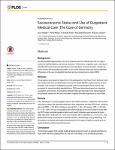Socioeconomic Status and Use of Outpatient Medical Care: The Case of Germany
Hoebel, Jens
Rattay, Petra
Prütz, Franziska
Rommel, Alexander
Lampert, Thomas
Background: Socially disadvantaged people have an increased need for medical care due to a higher burden of health problems and chronic diseases. In Germany, outpatient care is chiefly provided by office-based general practitioners and specialists in private practice. People are free to choose the physician they prefer. In this study, national data were used to examine differences in the use of outpatient medical care by socioeconomic status (SES). Methods: The analyses were based on data from 6,754 participants in the Robert Koch Institute’s German Health Interview and Examination Survey for Adults (DEGS1) aged between 18 and 69 years. The number of outpatient physician visits during the past twelve months was assessed for several medical specializations. SES was determined based on education, occupation, and income. Associations between SES and physician visits were analysed using logistic regression and zero-truncated negative binomial regression for count data. Results: After adjusting for sociodemographic factors and health indicators, outpatients with low SES had more contacts with general practitioners than outpatients with high SES (men: incidence rate ratio [IRR] = 1.25; 95% confidence interval [CI] = 1.08–1.46; women: IRR = 1.20; 95% CI = 1.07–1.34). The use of specialists was lower in people with low SES than in those with high SES when sociodemographic factors and health indicators were adjusted for (men: odds ratio [OR] = 0.68; 95% CI = 0.51–0.91; women: OR = 0.56; 95% CI = 0.41–0.77). This applied particularly to specialists in internal medicine, dermatology, and gynaecology. The associations remained after additional adjustment for the type of health insurance and the regional density of office-based physicians. Conclusion: The findings suggest that socially disadvantaged people are seen by general practitioners more often than the socially better-off, who are more likely to visit a medical specialist. These differences may be due to differences in patient preferences, physician factors, physician-patient interaction, and potential barriers to accessing specialist care.
No license information

